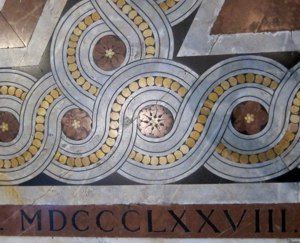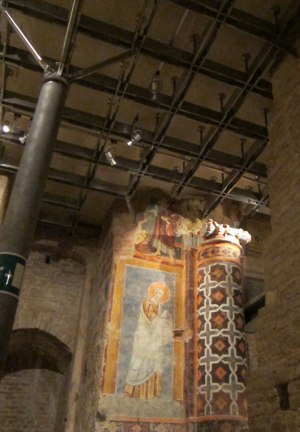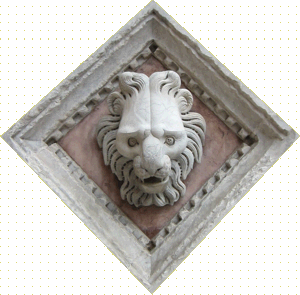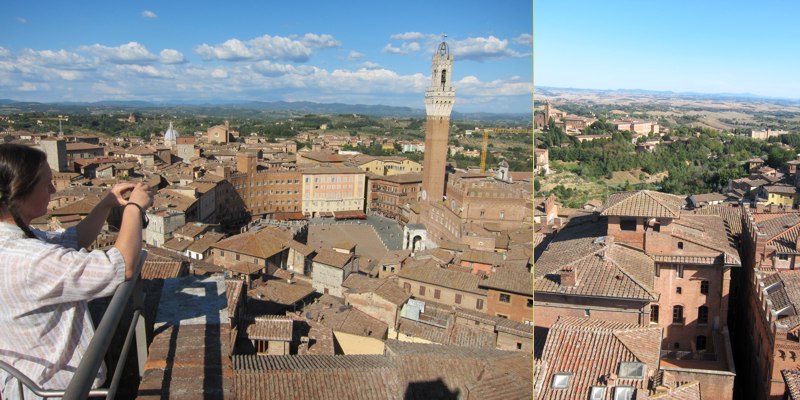| itinerary < Siena, Italia Siena, Tuscany, Italia 8 September Siena-Assisi, Italia > | Siena, Italia 6 September 2011 |
The Treasures of SienaArt day. Back to the museums – in this case the Duomo, under the care of OPA, the Senesi Catholic Mafia. Bad start: I went to the biglietteria and asked for four OPA Si tickets, the recommended pass for entry to all the OPA “attractions.” In theory, you can save $10 by buying the OPA Si pass when compared to buying an entry to (1) the Duomo, (2) the museo and belvedere, (3) the baptistry, and (4) the crypt. Something about selling tickets makes people sour. Maybe they're old Senese women disappointed in love for their priests. Maybe they just resent the crap out of foreigners. Probably they understand that selling you an OPA Si ticket isn't as profitable for OPA as selling you individual tickets; maybe they even get a percentage kickback when the “downsell.” |
 |
|
Anyway, What I got was a lot of indifference, hostility, and attitude, a very un-Italian coarseness, and four tickets to the Duomo and the wrong change. Unfortunately, I didn't realize this until I had left the window. The English-speaking young woman marshaling the lines and pushing the guided tours said, “No problem, just don't use the ticket, go back to that window and exchange it." I went to the indicated window and was informed, “no exchanges.” I tried to beg, and the troll in the window pointed to the back of the ticket as if the rule was printed on it, and insisted abruptly and with no patience at all, “NO EXCHANGES.” Only problem: the back of the ticket has no rules on it; nowhere is it indicated that tickets cannot be exchanged prior to use. I guess the take-away here is that Italian Catholics are infallible. So I tore up the tickets, worth 24 euros, and told her I wanted four OPA Si tickets, and handed over another 50 euro bill. She deliberately misunderstood me and dismissively motioned the next person in line forward. No, I wasn't going anywhere; I wanted the flaming tickets. (Even after losing 6 euros per ticket the OPA Si pass was a better deal.) Finally she got it, that the large angry American was going to block her window until he got what he asked for, and given that his requests had all been reasonable, maybe it was time to stop being a bitch for a minute. By the time I got my passes, Rochelle was ready to abandon the whole OPA hustle. But for the knowledge of what was within – “the most beautiful floor in the world,” and what I consider the most beautiful room in the world, the Libraria Piccolominei – I would have agreed. But all the age-old beauty quickly compensated for the tired dishonesty of the administration, and I quite forgot my anger … until now, as I write to warn potential visitors to insist on the full OPA Si ticket, then examine your tickets, count your fingers and your change before walking away from the OPA ticket troll. Ultimately, the joke was on me. I spent so long in the Piccolomini Library that I missed another room in the Duomo, the Bernini Chapel, with two wonderful scultures and a wonderful ceiling. Luckily, Sienna took pictures. When I tried to go back the next day with my pass, I was turned away – only one visit to each “attraction” per pass, said another sour troll with a barcode reader. The simony of the OPA administration is an embarrassment to churchgoers everywhere; their piratical money-changers are a sad scandal; but had I kept my mis-issued Duomo tickets I would have been able to re-enter the Duomo and complete my mission. Lesson learned? Probably not... |
 | PiccolominiA native Senesi who done good, Siena's favorite son, Aeneas Piccolomini, lived a full, favored, and fortunate life leading up to being crowned, literally, as Pope Pius II. Considered by many “the first humanist,” his story is the stuff of adventure novels, only the novel had not been invented yet and most of his people couldn't read, and so the library he (and his grateful town) erected next to their cathedral rehearses the story in ten astonishingly beautiful pictures, painted by Pinturicchio. The room is brightly lit from a north facing window, and candles were never used, so the art is as vivid and clear as it was when painted. I have reproduced, to the best of my (and the web's) ability, the glories of the Piccolomini Library here. |
|
The Duomo floor is a wonder: beautiful mosaic work that has withstood centuries of worshippers and gawkers, and still reflects a sense of humor and beauty, a sheer rejoicing with geometric shapes and the possibilities of storytelling on the floor with stone. The Duomo is itself an architectural masterpiece as well as a wondrous curiosity of stepwise refinement and the sad futility of ambition. This Duomo was meant by the Senese city fathers to be the transept of the greater Duomo to be built in answer to the upstart Firenzians' monster Duomo: In the 1330s building was begun on what was to be the greatest church in Christendom. But along came a plague, and the crash of the Senese bubble. |
 |
 |
The Crypt, the basement of the Duomo, is where you gain some insight into how to build a building on top of a building on top of a building … and then keep the result standing for a few more centuries. Built on a rocky and blessedly earthquake-free hilltop, the highest point in Siena, the ochre colored soil is nevertheless no match for the massive bulk of three versions of an ever-greater edifice begun in the 12th Century, rebuilt in the 13th, and finished in its present form in the 14th. 
Decapitated saints and topless columns from the earlier building disappear into the arches and footings of the later. Sagging floors that were supported by arches too shallow for their mass have been shored up with Italian engineering from the 21st Century that would look at home in a bridge or fast car. With all this attention to detail, and to the human qualities of the building, my only remaining question is, how can the building's keepers be so uncaring and rude? What does this tell us about the human benefits of religion as its precepts are applied to everyday life? Thousands of people come here every day, asking to be touched with wonder and love. Instead, they have to watch out for the official pickpockets. |
 | The Belvedere: atop the unfinishedThe southeast wall of the unfinished Duomo is pierced by two tight spiral staircases that lead high above the Duomo's hilltop, and everything else in Siena (except maybe the City Hall tower, and with 200 fewer steps.) Rick Steves makes the point that Siena, and visitors thereto, gather more around their Campo and City Hall than they do around the Duomo. Like Firenze, the commercial aspect of life was more rewarding to these practical Tuscans than the spiritual, unless you were gifted like Piccolomini. We wait in a hot crowded room for most of an hour to climb up the stairs while an indifferent troll counts comings and goings. From the belvedere, named the Panorama del Facciatone, you can see all of Tuscany and a bit into Umbria. To the northwest, the large piazza and parking lot would have been the nave of the wannabe new Duomo. Beyond, the huge pile of San Domenico, the Stadio, la Fortezza, and La Lizza, where on Wednesdays there's a giant flea market with even a few farmers selling food. All around you, the town spills down the hills in a rumpled mass of tile roofs, nary a straight line or right angle amongst them. In most directions you can see the old city huddled within remnants of its city walls. There to the east is the Campo, the fulcrum of Siena. |
 Sienna picturing the Campo, the road to tomorrow |
 |
updated 16 June 2023 Caspar Time site software and photographs by the Caspar Institute except as noted this site generated with 100% recycled electrons! send website feedback to the CI webster © copyright 2002-2024 Caspar Institute |